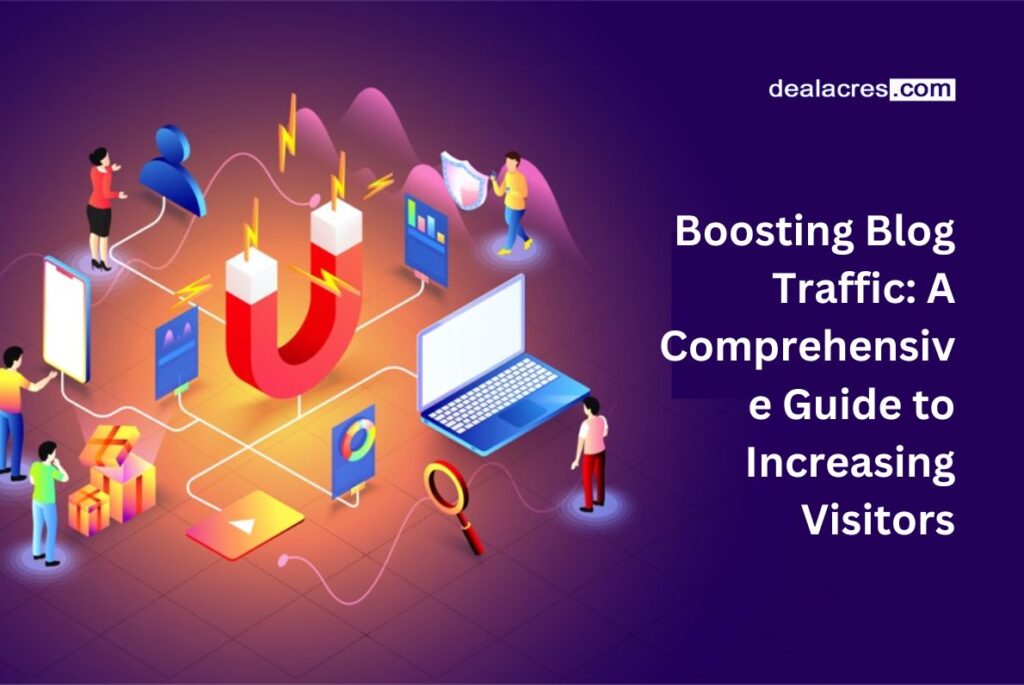Introduction:
So, you’ve got a blog and some fantastic content ready to share with the world. But wait – where are all the visitors? In the vast online landscape, attracting a steady stream of readers to your blog can be a challenge. Fret not! In this comprehensive guide, we’ll unravel a plethora of strategies to help you boost your blog traffic. From optimizing content to leveraging social media, let’s explore the tools and techniques that will turn your blog into a bustling hotspot for visitors.
Section 1: Quality Content is King

1.1 Understanding Your Audience:
Before diving into tactics, let’s start with the foundation – understanding your audience. Knowing who you’re writing for allows you to tailor your content to their interests, questions, and needs. Conduct audience research to uncover the topics that resonate with your target readers.
1.2 Creating Engaging and Valuable Content:
Quality content is the backbone of any successful blog. Craft posts that are informative, engaging, and offer real value to your audience. Address their pain points, provide solutions, and keep your content fresh and up-to-date.
1.3 Regular Posting Schedule:
Consistency matters. Establish a regular posting schedule, whether it’s daily, weekly, or bi-weekly. This not only keeps your audience engaged but also signals to search engines that your blog is active and relevant.
Section 2: Search Engine Optimization (SEO)
2.1 Keyword Research:
Optimizing your content for search engines involves identifying and strategically using relevant keywords. Conduct thorough keyword research to understand what terms your audience is searching for and incorporate them naturally into your content.

2.2 On-Page SEO:
Optimize your blog posts for on-page SEO by including keywords in titles, headings, meta descriptions, and throughout the content. Use descriptive and engaging meta titles and descriptions to encourage clicks from search engine results pages (SERPs).
2.3 Quality Backlinks:
Build a network of quality backlinks by collaborating with other bloggers, contributing guest posts, and participating in forums or communities related to your niche. Backlinks from reputable sites can significantly boost your blog’s visibility in search results.
Section 3: Social Media Promotion
3.1 Choose the Right Platforms:
Not all social media platforms are created equal. Identify the platforms where your target audience is most active and tailor your promotion efforts accordingly. For example, visual content may perform well on Instagram, while professional content could thrive on LinkedIn.
3.2 Consistent Branding:
Maintain a consistent brand image across all social media platforms. This includes using the same profile picture and bio information and linking back to your blog. Consistent branding builds recognition and trust.
3.3 Engage with Your Audience:
Don’t just broadcast – engage. Respond to comments, ask questions, and actively participate in discussions. Building a community around your blog increases loyalty and encourages readers to share your content.
Section 4: Email Marketing
4.1 Build an Email List:
Email marketing remains a powerful tool for engaging with your audience. Build an email list by offering valuable incentives such as exclusive content, discounts, or free resources. Use prominent sign-up forms on your blog to encourage subscriptions.
4.2 Send Regular Newsletters:
Once you’ve built your email list, send regular newsletters to keep your subscribers informed about your latest blog posts, promotions, or exclusive content. Craft compelling subject lines to entice opens and optimize the content for click-throughs.
4.3 Personalized Communication:
Segment your email list based on user behaviour or preferences. Tailor your communications to specific segments, offering personalized content and recommendations. Personalization enhances the reader’s experience and increases the likelihood of continued engagement.
Section 5: User Experience and Blog Design
5.1 Mobile Optimization:
With an increasing number of users accessing the internet via mobile devices, it’s crucial to optimize your blog for mobile. Ensure that your site is responsive, loads quickly, and provides a seamless experience across different devices.
5.2 Easy Navigation:
A user-friendly interface is key to retaining visitors. Implement easy navigation with clear menu structures, a search bar, and strategically placed calls to action. Simplify the user journey to make it easy for readers to find what they’re looking for.
5.3 Appealing Visuals:
Visual appeal matters. Use high-quality images, infographics, and multimedia elements to break up text and make your content visually engaging. A well-designed blog not only attracts visitors but also encourages them to stay longer.
Section 6: Collaborations and Networking
6.1 Collaborate with Other Bloggers:
Collaborate with fellow bloggers in your niche to tap into their audience. This could involve co-authoring posts, participating in joint projects, or featuring each other’s content. Cross-promotion widens your reach and introduces your blog to new audiences.
6.2 Attend and Host Webinars or Podcasts:
Participate in webinars or podcasts related to your niche to showcase your expertise and reach new audiences. Similarly, consider hosting your own webinars or podcasts featuring guests who bring value to your audience.
6.3 Participate in Online Communities:
Engage in online communities and forums relevant to your niche. Contribute to discussions, answer questions, and share your expertise. Building a presence in these communities establishes you as an authority and attracts visitors curious to learn more from your blog.
Section 7: Analyze and Adapt

7.1 Use Analytics Tools:
Leverage analytics tools such as Google Analytics to understand your blog’s performance. Track metrics like page views, bounce rate, and popular content. Analyzing data helps you identify what’s working and where improvements can be made.
7.2 A/B Testing:
Experiment with A/B testing to optimize various elements of your blog, including headlines, calls-to-action, and layouts. Testing different versions allows you to identify the most effective strategies for increasing engagement and conversion rates.
7.3 Stay Updated on Trends:
The digital landscape is ever-evolving. Stay informed about the latest trends in blogging, SEO, and content marketing. Adapting to emerging trends ensures that your blog remains relevant and continues to attract a growing audience.
Conclusion:
Congratulations! You’ve reached the end of our comprehensive guide on increasing blog traffic. By implementing the strategies outlined in this guide, you’re well on your way to transforming your blog into a vibrant hub for readers. Remember, building blog traffic is an ongoing process that requires dedication, creativity, and adaptability. So, go ahead, apply these techniques, and watch as your blog attracts a steadily increasing number of visitors, creating a thriving community around your valuable content.




